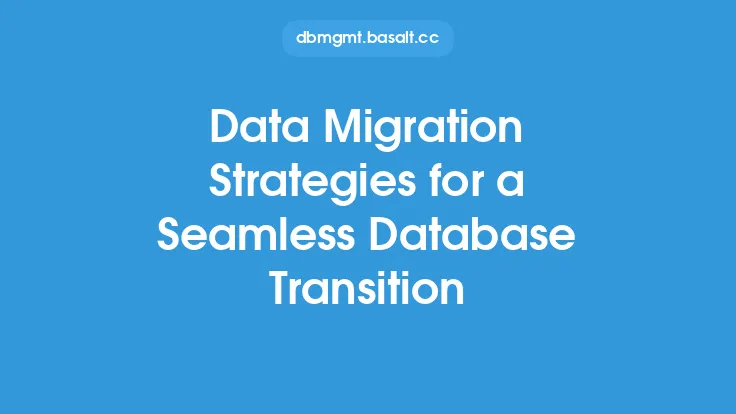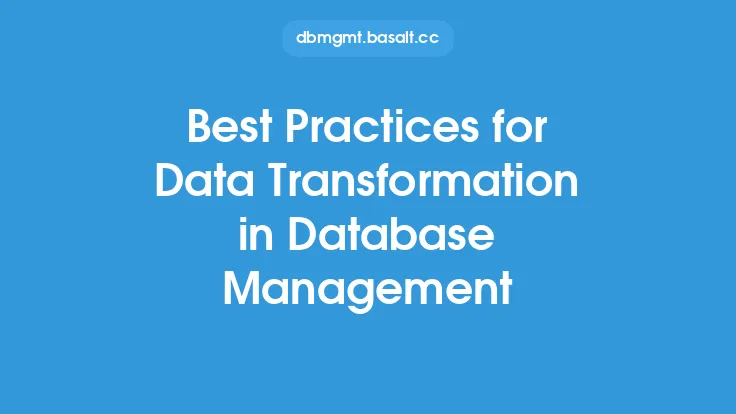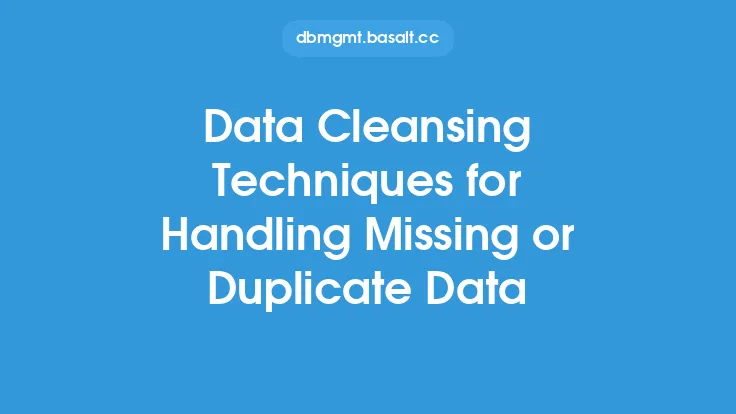Data integration is a critical process in today's data-driven world, where organizations need to combine data from multiple sources to gain insights and make informed decisions. However, integrating data from different sources can be a challenging task, especially when the data is in different formats, structures, and scales. This is where data transformation techniques come into play, enabling seamless data integration by converting data into a standardized format that can be easily analyzed and processed.
Introduction to Data Transformation
Data transformation is the process of converting data from one format to another, making it compatible with the target system or application. It involves a series of steps, including data cleaning, data mapping, and data conversion, to ensure that the data is accurate, complete, and consistent. Data transformation techniques are essential for data integration, as they enable organizations to combine data from different sources, such as databases, files, and applications, into a single, unified view.
Types of Data Transformation
There are several types of data transformation techniques, each with its own strengths and weaknesses. Some of the most common types of data transformation include:
- Data Aggregation: This involves combining data from multiple sources into a single dataset, using techniques such as grouping, filtering, and sorting.
- Data Mapping: This involves creating a mapping between the source and target data structures, to ensure that the data is correctly transformed and loaded into the target system.
- Data Conversion: This involves converting data from one format to another, such as converting date formats or data types.
- Data Cleansing: This involves identifying and correcting errors in the data, such as handling missing or duplicate values.
Data Transformation Techniques
There are several data transformation techniques that can be used to integrate data from different sources. Some of the most common techniques include:
- ETL (Extract, Transform, Load): This involves extracting data from multiple sources, transforming it into a standardized format, and loading it into a target system.
- ELT (Extract, Load, Transform): This involves extracting data from multiple sources, loading it into a target system, and then transforming it into a standardized format.
- Data Virtualization: This involves creating a virtual layer on top of the source data, to provide a standardized view of the data without physically moving or transforming it.
- Data Warehousing: This involves creating a centralized repository of data, where data is transformed and loaded into a standardized format for analysis and reporting.
Data Transformation Tools and Technologies
There are several data transformation tools and technologies available, each with its own strengths and weaknesses. Some of the most common tools and technologies include:
- Data Integration Platforms: These are software platforms that provide a range of data transformation tools and technologies, such as ETL, ELT, and data virtualization.
- Data Transformation Languages: These are programming languages, such as SQL and Python, that are used to transform and manipulate data.
- Data Mapping Tools: These are software tools that provide a graphical interface for creating data mappings between source and target data structures.
- Data Quality Tools: These are software tools that provide a range of data quality functions, such as data cleansing, data validation, and data certification.
Best Practices for Data Transformation
To ensure that data transformation is successful, there are several best practices that should be followed. Some of the most common best practices include:
- Define Clear Requirements: Clearly define the requirements for the data transformation project, including the source and target data structures, and the transformation rules.
- Use Standardized Data Formats: Use standardized data formats, such as CSV or JSON, to ensure that the data is compatible with the target system.
- Test and Validate: Test and validate the data transformation process, to ensure that the data is accurate and complete.
- Document the Process: Document the data transformation process, including the transformation rules and the data mappings, to ensure that the process can be repeated and maintained.
Challenges and Limitations of Data Transformation
Data transformation can be a complex and challenging process, especially when dealing with large volumes of data or complex data structures. Some of the most common challenges and limitations include:
- Data Quality Issues: Data quality issues, such as missing or duplicate values, can make it difficult to transform and integrate data.
- Data Complexity: Complex data structures, such as hierarchical or graph data, can make it difficult to transform and integrate data.
- Scalability: Large volumes of data can make it difficult to transform and integrate data, especially when using traditional data transformation techniques.
- Security and Governance: Data transformation can raise security and governance concerns, especially when dealing with sensitive or confidential data.
Future of Data Transformation
The future of data transformation is likely to be shaped by several trends and technologies, including:
- Cloud Computing: Cloud computing is likely to play a major role in the future of data transformation, enabling organizations to transform and integrate data in a scalable and on-demand manner.
- Artificial Intelligence: Artificial intelligence is likely to play a major role in the future of data transformation, enabling organizations to automate and optimize the data transformation process.
- Big Data: Big data is likely to play a major role in the future of data transformation, enabling organizations to transform and integrate large volumes of data from a variety of sources.
- Real-Time Data Integration: Real-time data integration is likely to become increasingly important, enabling organizations to transform and integrate data in real-time, and make decisions based on up-to-the-minute data.





